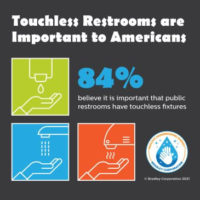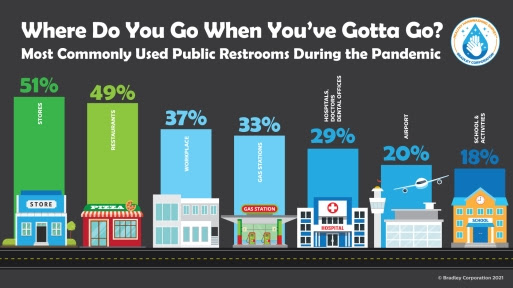According to a national survey by Bradley Corp., half of the population continued to use public restrooms throughout the pandemic. Just 13% of Americans said they completely avoided using a public restroom while 50% visited restrooms just as they always had. Another 37% said they were uncomfortable but had, at times, utilized a public restroom Read more
Sloan touchless faucets

According to a national survey by Bradley Corp., half of the population continued to use public restrooms throughout the pandemic. Just 13% of Americans said they completely avoided using a public restroom while 50% visited restrooms just as they always had. Another 37% said they were uncomfortable but had, at times, utilized a public restroom when necessary.
The most common places where Americans used a public restroom were stores, restaurants and their workplace. The majority who visited public restrooms took precautions to reduce their likelihood of coming in contact with germs. 63% had ahold of a paper towel as a protective barrier when they operated the toilet flusher and faucet handles or reached for door handles. Alternately, another group employed their foot to flush the toilet or opened and closed doors with their butt.

The annual Healthy Handwashing Survey from Bradley Corp. queried 1,050 American adults regarding their public restroom usage, handwashing habits and concerns about the coronavirus and flu. Participants were from around the country and were evenly split between men and women.
Strong Preference for Touchless
Since Americans have relied on evasive measures to avoid germs in public restrooms, it’s not surprising that 84% believe it’s important to have touchless fixtures. In fact, nearly 70% say they’re more likely to return to a business that has touchless restroom features. On the other hand, 56% have a negative impression of a business that doesn’t have touchless fixtures.
When it comes to which fixtures Americans prefer to be touchless, the toilet flusher, faucets and entrance doors top the list.
“Touchless restroom fixtures add a significant level of comfort for Americans when they’re out and about and need to use a public restroom,” says Jon Dommisse, director of strategy and corporate development for Bradley Corp. “We’ve all become more cognizant of potentially germy touch points so eliminating an area of concern is another way we can help resume our normal lives again.”

Germ Concerns Significant
The Healthy Handwashing Survey, which was conducted in January 2021, found that 86% of Americans are more conscious about coming in contact with germs as a result of the Coronavirus.
That concern has led to a spike in handwashing and hand drying. The survey revealed that nearly 90% are washing their hands more frequently or more thoroughly as a result of the Coronavirus. In terms of frequency, 57% are sudsing up between six to 15 or more times a day. And, 73% are drying their hands more frequently or more thoroughly.
That’s significant because hand drying is an important step in the handwashing process. The Centers for Disease Control and Prevention (CDC) explains that, “Germs can be transferred more easily to and from wet hands; therefore, hands should be dried after washing.”
Overall, Americans correctly believe handwashing is a better germ-fighter than hand sanitizer. 61% understand their hands are less germy after washing with soap and water than after using hand sanitizer – a fact supported by the CDC. For times when soap and water are not available, the CDC says that using hand sanitizer is a good, second option for hand hygiene.
“Handwashing remains one of the easiest and most effective ways to stay healthy and reduce the likelihood of spreading germs or viruses to others,” says Dommisse. “When you pair soap and water with vigorous and thorough scrubbing, you’re literally removing and sending bacteria and germs down the drain.”
For more information, visit bradleycorp.com/handwashing.

Visitors come to the Hyatt Regency O’Hare hotel, Chicago’s sixth-largest hotel, because of its close proximity to O’Hare Airport, its covered walkway to the Donald E. Stephens Convention Center and its easy access to downtown Chicago. Now, following an interior facelift, guests may find the hotel’s contemporary décor and high-tech features to be equally enticing—including Read more
Visitors come to the Hyatt Regency O’Hare hotel, Chicago’s sixth-largest hotel, because of its close proximity to O’Hare Airport, its covered walkway to the Donald E. Stephens Convention Center and its easy access to downtown Chicago.

Now, following an interior facelift, guests may find the hotel’s contemporary décor and high-tech features to be equally enticing—including the public restrooms in its lobby, which have a draw of their own thanks to a complete makeover featuring the latest in Sloan touchless commercial restroom products.
 The new public restrooms feature slate-gray panels with all white Sloan ceramic bowls and bright chrome fixtures that offer a clean, fresh and decidedly high-tech aesthetic.
The new public restrooms feature slate-gray panels with all white Sloan ceramic bowls and bright chrome fixtures that offer a clean, fresh and decidedly high-tech aesthetic.
Restrooms feature Sloan water closets with Sloan 8115 exposed, battery-powered sensor-activated flushometers, urinals with Sloan 8186 sensor-activated flushometers, Sloan EAF 250 touch-free faucets and ADA-compliant sinks with large mirrors, each with its own television.
 The overall result is a state of the art, touchless Sloan product corridor that is not only beautiful to the eye, but functional and hygienic—with no need to touch any of the fixtures.
The overall result is a state of the art, touchless Sloan product corridor that is not only beautiful to the eye, but functional and hygienic—with no need to touch any of the fixtures.
“With Sloan you never have to touch the product,” says Tony Fiore, Hyatt Regency O’Hare senior director of engineering. “The sensors allow the users to go touch free, and the reliability of these products leaves me with nothing to worry about. Literally the only people that touch them are housekeeping during their daily cleaning of the bathrooms.”
